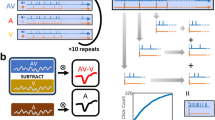Abstract
Experiments on conscious rabbits were performed using the oddball paradigm, in which a rare (deviant) and common (standard) stimuli were of the same color but different intensities. Deviant stimuli were of lesser intensity. Recordings were made of evoked potentials induced by series of uniform deviant stimuli (without using standard stimuli), which were presented at the beginning and end of stimulation. Visual evoked potentials recorded in response to deviant stimuli in the visual cortex and hippocampus showed increases in the amplitudes of phases, shifted towards positivity as compared with responses to standard stimuli and uniform deviant stimuli at the beginning and end of stimulus blocks. Significant changes affected phases P1 and P2 of visual evoked potentials in the cortex and phases P1, N1, and P2 in the hippocampus. The most significant increase in evoked potentials in the cortex was seen for the P2 peak (P130). It is suggested that changes in responses to oddball-deviant stimuli result from an orienting reflex to rare, unexpected stimuli and that the P2 (P130) peak in the cortex is associated with transmission of information regarding changes in the intensity of the light. The amplitude of this peak was shown to be decreased in responses to uniform deviant stimuli at the beginning and end of stimulus blocks. It was also demonstrated that the clearest and most contrasting changes in visual evoked potentials in responses to deviant and standard stimuli were seen with the smallest differences in intensity between these types of stimulus, this reflecting increases in the orienting reflex at threshold differences.
Similar content being viewed by others
REFERENCES
O. S. Vinogradova, The Hippocampus and Memory [in Russian], Nauka, Moscow (1975).
V. B. Polyanskii, D. V. Evtikhin, and E. N. Sokolov, “Brightness components of visual evoked potentials to colored stimuli in the rabbit,” Zh. Vyssh. Nerv. Deyat., 49,No. 6, 1046 (1999).
V. B. Polyanskii and T. V. Isakova, “Inversion of evoked potentials to color in the rabbit visual cortex,” Zh. Vyssh. Nerv. Deyat., 15,No. 1, 140 (1965).
E. N. Sokolov, N. I. Nezlina, V. B. Polyanskii, and D. V. Evtikhin, “The orientational reflex: a targeting reflex and the projector of attention,” Zh. Vyssh. Nerv. Deyat., 51,No. 4, 421 (2001).
P. Astikainen, T. Ruusivirta, and T. Korhonen, “Cortical and subcortical visual event-related potentials to oddball stimuli in rabbits,” Neuroreport, 11,No. 7, 1515 (2000).
P. Astikainen, T. Ruusivirta, and T. Korhonen, “Somatosensory event-related potentials in the rabbit cerebral and cerebellar cortices: a correspondence with mismatch responses in humans,” Neurosci. Lett., 298, 222 (2001).
V. Csepe, “On the origin and development of the mismatch negativity,” Ear. Hear., 16,No. 1, 91 (1995).
V. Csepe, G. Karmos, and M. Molnar, “Evoked potential correlates of stimulus deviance during wakefulness and sleep in cat — animal model of mismatch negativity,” EEG Clin. Neurophysiol., 66,No. 6, 571 (1987).
J. L. Kenemans, M. N. Verbaten, C. J. Melis, et al., “Visual stimulus change and the orienting reaction: event-related potential evidence for a two-stage process,” Biol. Physiol., 33,No. 2–3, 97 (1992).
J. L. Kenemans, M. N. Verbaten, J. W. Roelofs, et al., “‘Initial’ and ‘change-orienting reactions’: an analysis based on visual dingle-trial event-related potentials,” Biol. Physiol., 28,No. 3, 199 (1989).
R. Naatanen, “Mismatch negativity (MMN): perspectives for application,” Int. J. Psychophysiol., 37,No. 1, 3 (2000).
R. Naatanen and K. Alho, “Mismatch negativity — a unique measure of sensory processing in audition,” Int. J. Neurosci., 80,No. 1–4, 317 (1995).
R. Naatanen, A. W. K. Gaillarg, and S. Mantysalo, “Early selection attention effect on evoked potential reinterpreted,” Acta Psychol., 42, 313 (1978).
R. Naatanen, P. Paavilainen, H. Tirtinen, et al., “Attention and mismatch negativity,” Psychophysiology, 30,No. 5, 436 (1993).
Z. Pincze, P. Lakatos, C. Rajkai, et al., “Separation of mismatch negativity and the N1 wave in the auditory cortex of the cat: a topographic study,” Clin. Neurophysiol., 112,No. 5, 778 (2001).
T. Ruusivirta, T. Korhonen, J. Arikoski, et al., “ERP to pitch changes: a result of reduced responses to standard tones in rabbits,” Neuroreport, 7,No. 2, 413 (1996).
T. Ruusivirta, T. Korhonen, J. Arikoski, et al., “Multiple-unit responses to pitch changes in rabbits,” Neuroreport, 7,No. 7, 1266 (1996).
T. Ruusivirta, M. Penttonen, and T. Korhonen, “Auditory cortical event-related potentials to pitch deviances in rats,” Neurosci. Lett., 248,No. 1, 45 (1998).
T. Shinba, “Neuronal firing activity in the dorsal hippocampus during the auditory discrimination oddball task in awake rats: relation to event-related potential generation,” Brain Res. Cogn. Brain Res., 8,No. 3, 241 (1999).
N. Shinozaki, H. Jabe, S. Takeyuki, et al., “Somatosensory automatic responses to deviant stimuli,” Cogn. Brain Res., 7, 165 (1998).
A. Tales, P. Newton, T. Troscianko, et al., “Mismatch negativity in the visual modality,” Neuroreport, 10,No. 16, 3363 (1999).
Author information
Authors and Affiliations
Rights and permissions
About this article
Cite this article
Polyanskii, V.B., Evtikhin, D.V. & Sokolov, E.N. Reflection of an Orienting Reflex in the Phases of Evoked Potentials in the Rabbit Visual Cortex and Hippocampus during Substitution of Stimulus Intensity. Neurosci Behav Physiol 34, 19–28 (2004). https://doi.org/10.1023/B:NEAB.0000003242.21874.1f
Issue Date:
DOI: https://doi.org/10.1023/B:NEAB.0000003242.21874.1f




